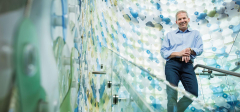Walking with Michl Binderbauer into his 2-acre laboratory feels a bit like taking a factory tour with Willy Wonka. In one corner Binderbauer, chief executive of TAE Technologies, shows off a new machine that blasts cancer tumors with a neutron beam. Engineers huddle in a control room. Beyond their window: Norman.
That’s the name of TAE’s 100-foot-long prototype nuclear fusion reactor, a magnificent assemblage of stainless steel vessels, electromagnets and particle accelerator tubes. Once every eight minutes Norman emits a clang, as it transforms 100 million watts of electricity into a cloud of 30 million degree Celsius plasma that it blasts with beams of protons (the simplest form of hydrogen). They smash together with enough force to fuse into helium—releasing copious amounts of energy in the process. “It’s a function of violence,” says Binderbauer, 50, with a smile.
TAE, known until last year as Tri Alpha Energy, has raised $600 million, most recently at a valuation of more than $2 billion. Investors include the late Paul Allen’s Vulcan Capital, the Rockefeller family’s Venrock, and Big Sky Capital, family money of billionaire stock trader Charles Schwab. They’re betting that TAE will be able to tame fusion into a source of electricity.
Plasma Balls: TAE has run more than 12,000 experimental shots through Norman, its $100 million particle collider.
Tim Pannell for Forbes
Fission, which powers several hundred nuclear plants, is the splitting of uranium atoms into medium-size atoms to release energy. Fusion, which makes the stars glow, goes the other way, combining small atoms into larger ones to release energy. Fission carries the risk of a meltdown and creates radioactive waste that has to be set aside for 10,000 years. Fusion promises to be meltdown-proof and waste-free.
“With fission it’s a chain reaction—once you’re in, it’s a like a pact with the devil; it’s hard to get out,” says Binderbauer, an effusive talker who runs TAE from a eucalyptus-lined industrial park southeast of Los Angeles. “With fusion you don’t have that. It’s tricky to get started and even trickier to keep going.”
Tricky—or impossible. Binderbauer likens the process of controlling a ball of plasma to holding a spinning ball of liquid Jell-O in place with rubber bands: “We struggle with a millionth of a second, and the stuff oozes away.” Thirty million degrees, moreover, is too cool; TAE aims for 2 billion degrees, eventually.
Russian physicists began working on fusion in the 1950s. They thought a commercial reactor might be ready in 15 years. That’s been the forecast ever since. In a corner of the laboratory, Binderbauer keeps a gallery of past fusion prototypes, none of which produced more electricity than it consumed.
But the believers keep coming. “Right now, nuclear technology is one of our best scalable, baseload, zero-carbon power sources,” Bill Gates says in a statement. “But it comes with a number of challenges.”
Gates is putting money into a Massachusetts Institute of Technology fusion spinoff called Commonwealth Fusion Systems, which hopes to have an energy-positive reactor by 2025. Digital billionaires Peter Thiel and Jeff Bezos are backing yet other fusion schemes. They’re all competing with a multinational project in France that is using $20 billion of taxpayer money.
The 100-foot-long fusion machine dubbed Norman was built in 2017.
Courtesy TAE Technologies
“I understood the limitations of renewables,” says Charles Schwab’s son Michael, who invested $50,000 in Tri Alpha in 2002 when he was 25 and has participated in every funding round since. “This could solve our energy problems.”
What makes fusion safer than fission? The reactor is under vacuum, explains David Hill, director of a fusion test reactor at General Atomics in San Diego. “Any leaks are inward, and a leak would put the fire out.” Besides, he says, there’s nothing to melt down. “If you turned all the plasma into a solid” and piled it up, the amount “is less than a grain of salt.”
Tri Alpha Energy got its start with Norman Rostoker (1925–2014), a Canadian who taught at the University of California, Irvine, and in 1988 won the Maxwell Prize for plasma physics. He and Glenn Seaborg, the Nobelist discoverer of plutonium, saw the technical limitations of the consensus





